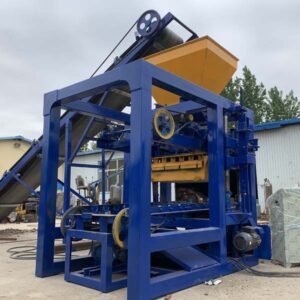
The construction industry has long been a cornerstone of human progress, shaping the landscapes we inhabit and the societies we build.
However, as the world grapples with increasing population growth, urbanization, and environmental concerns, the need for innovative and sustainable building solutions has become more urgent than ever.
Enter the cutting-edge block making machine – a technological marvel that is reshaping the way we construct buildings, offering unprecedented levels of efficiency and sustainability.
In this essay, we will delve into the transformative impact of these machines on the construction landscape, exploring their mechanisms, benefits, challenges, and the broader implications for a more sustainable future.
The Mechanics of Modern Block Making Machines
At the heart of the construction revolution lies the intricate mechanics of modern block making machines.
These machines have evolved far beyond their predecessors, incorporating advanced technologies to streamline and enhance the block production process.
Typically, a block making machine operates by combining raw materials such as cement, aggregate, and water to create uniform blocks or bricks of varying sizes and specifications.
One of the key innovations is automation, which eliminates much of the manual labor traditionally associated with block production.
Computer-controlled systems precisely measure and mix the materials, ensuring consistent quality and minimizing waste.
The blocks are then formed and compacted using hydraulic or pneumatic pressure systems, resulting in durable and structurally sound units.
Efficiency Redefined: Enhancing Construction Practices
Efficiency is a cornerstone of the construction industry, and modern block making machines are transforming the way projects are executed.
These machines offer a range of benefits that significantly improve the efficiency of construction practices.
Firstly, the automation of block production reduces the reliance on human labor, mitigating the impact of skilled labor shortages and potentially hazardous working conditions.
This not only increases the speed of construction but also enhances worker safety.
Secondly, the precision and uniformity achieved by block making machines lead to reduced waste and material consumption.
This is particularly crucial in a world where sustainable resource management is paramount. Additionally, the consistent quality of the blocks contributes to improved structural integrity and longevity of buildings.
Furthermore, these machines enable rapid scalability of construction projects.
Whether building a single-family home or a large-scale commercial complex, the versatility of block making machines ensures a seamless transition between different project scales.
Sustainability in Construction: Environmental and Social Implications
The global construction industry has a significant environmental footprint, from resource extraction to energy consumption and waste generation.
In this context, the adoption of cutting-edge block making machines holds immense promise for sustainable development.
Reduced Carbon Footprint: Traditional brick manufacturing processes are energy-intensive and often rely on the burning of fossil fuels, leading to substantial carbon emissions.
Modern block making machines, on the other hand, optimize energy use through efficient material compaction and curing methods.
Additionally, some machines incorporate alternative materials like fly ash or recycled aggregates, further reducing their environmental impact.
Waste Reduction: The construction sector is notorious for generating vast amounts of waste.
Block making machines address this issue by minimizing material wastage through precise measurements and uniform compaction.
Moreover, the durability and longevity of blocks produced by these machines reduce the need for frequent replacements, minimizing long-term waste.
Affordable Housing: Beyond environmental benefits, block making machines have the potential to revolutionize affordable housing initiatives.
By streamlining construction processes, these machines can significantly lower overall project costs, making quality housing more accessible to underserved communities.
Challenges and Future Prospects
While the advent of cutting-edge block making machines offers a multitude of advantages, it is not without its challenges and considerations.
Acquiring and implementing modern block making machines can involve a substantial upfront investment. Small-scale contractors and organizations with limited resources may find it challenging to adopt this technology, hindering its widespread adoption.
Operating and maintaining these advanced machines requires a certain level of technical expertise.
Training workers to effectively manage the equipment and troubleshoot potential issues can be time-consuming and costly.
The construction industry is subject to a variety of regulations and building codes that may not always accommodate the use of new technologies.
Advocacy and collaboration between industry stakeholders and regulatory bodies are essential to overcome these barriers.
Conclusion: Paving the Way to a Sustainable Future
In conclusion, the cutting-edge block making machine represents a transformative force in the construction industry, offering efficient and sustainable building solutions that address pressing global challenges.
By harnessing automation, precision, and innovative materials, these machines redefine construction practices, enhance efficiency, and contribute to a more sustainable built environment.
While challenges such as initial investment and technical expertise remain, the potential benefits far outweigh these obstacles.
As the world continues to prioritize sustainability and resilience, the adoption of modern block making machines holds the promise of revolutionizing the construction landscape, one block at a time.
Through collaboration, innovation, and a commitment to a greener future, these machines pave the way towards a more sustainable and prosperous world.
